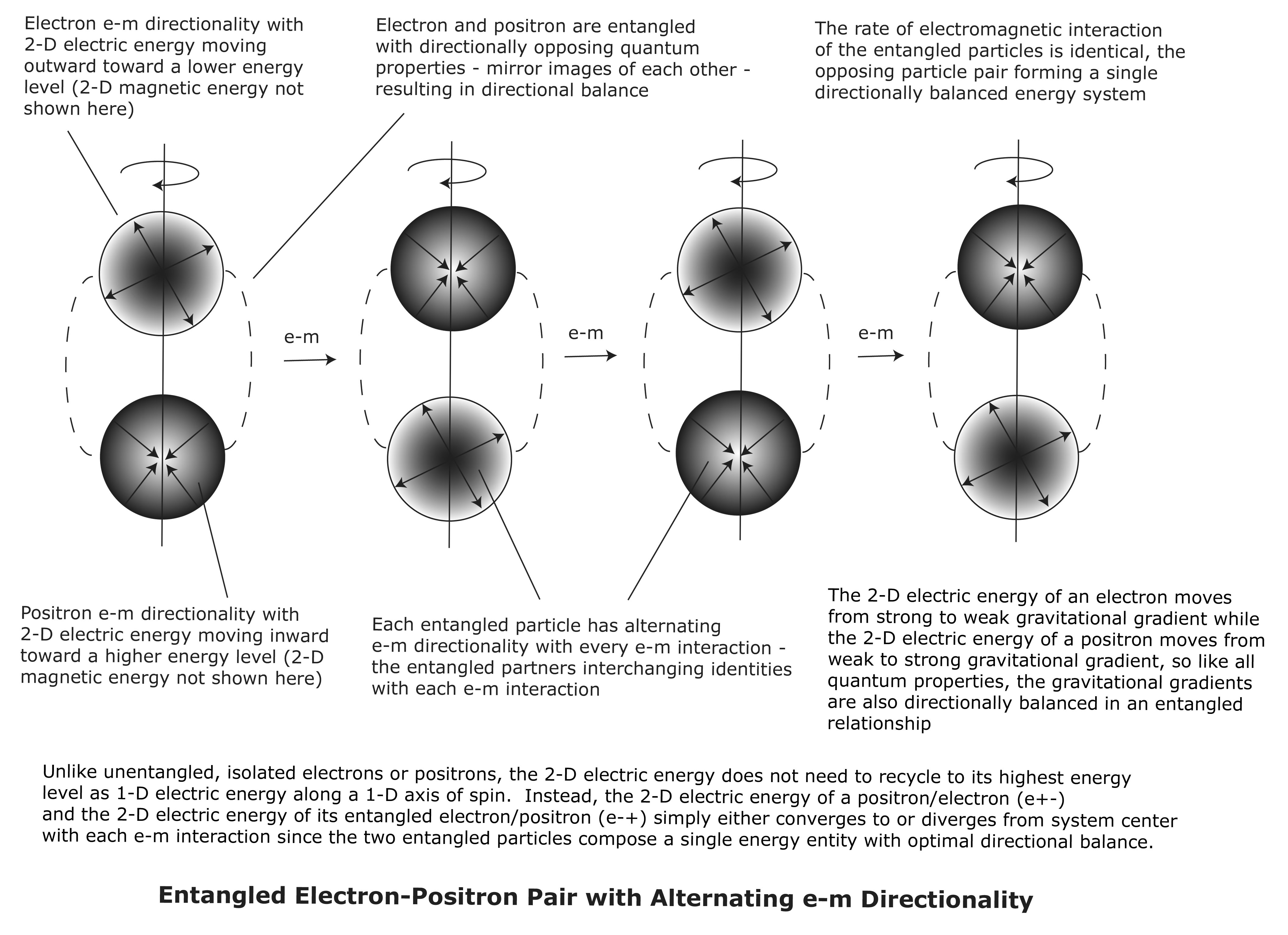 All energy, if left alone, moves toward its lowest possible energy level – its laziest existence.
All energy, if left alone, moves toward its lowest possible energy level – its laziest existence.
Entanglement is one way in which electromagnetic energy can exist at a low energy level through directional balance.
Entanglement, as used in this model, involves two or more electromagnetic (e-m) energy systems that provide directional balance to each other. A single energy system may break down into two smaller energy systems that are entangled with each other as ‘siblings.’ These two smaller energy systems possess equal and opposing properties to maintain directional balance and, in the process, conserve the original properties from their parent energy system.
Entangled e-m particles may consist of alternating e-m directionality with each e-m interaction. For example, one particle may start out as an electron while its entangled partner begins as a positron. Then, with the next e-m interaction, the electron converts to a positron, and the positron becomes an electron. The process then repeats itself, so that with every e-m interaction, the two partners exchange identities (i.e., interchanging identities). Unlike an isolated or unentangled electron or positron, the 2-D electrical energy of the e-m particles does not need to recycle back to their highest energy level through a 1-D axis of spin as 1-D electric energy. Instead, the 2-D electric energy simply moves inward toward system center or outward away from system center since the two entangled partners compose a single, directionally balanced energy entity.
The 2-D electric energy of an electron moves outward from system center from a strong gravitational energy gradient with a high ratio of potential:kinetic energy (of the inherent energy of space) toward lower and lower ratios of potential:kinetic energy of space. On the other hand, the 2-D electric energy of a positron moves inward from the outer boundary from a weak gravitational energy gradient with a low ratio of potential:kinetic energy of space toward higher and higher ratios of potential:kinetic energy of space. So in the case of entangled particles with alternating e-m directionality with every e-m interaction, the gravitational gradients are directionally balanced and cancel each other’s effects – just as in the case of quantum properties such as charge and spin.
Non-identical e-m energy, such as a 2-D positron-electron particle and a 1-D neutrino/anti-neutrino particle may be entangled, as in the case of a beta particle (i.e, electron) and an anti-neutrino being emitted from a nucleus. But this is only a partial entanglement since one or more properties of the entangled e-m energy systems cannot be directionally balanced through alternating e-m directionality. For example, the 2-D particle will possess a gravitational energy gradient while the 1-D neutrino/antineutrino particle will not. So the gravitational gradient cannot be directionally balanced. And it is likely that such a weak entanglement will be very short-lived.
Non-identical entangled 1-D e-m pairs (i.e., photons, neutrinos) do not possess a gravitational energy gradient because such a gradient is composed of basic 1-D units of the energy of space, and creates an energy gradient covering 2-D or 3-D space. Instead, the path of v = c for 1-D particles (without a gravitational energy gradient) is the 1-D analogy of the center of gravity. Even though, a 1-D photon and a 1-D neutrino are not identical particles, and therefore can only be partially entangled, they may nevertheless compose a relatively stable entangled structure.
Other entangled relationships will be discussed later on this website, including partial entanglements, simultaneous vs. sequential entanglement, entangled particles with interchanging identities, and entanglement within atomic energy systems.
